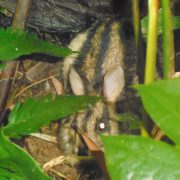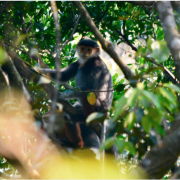Annamite striped rabbit
The Annamite striped rabbit (Nesolagus timminsi) is one of the most interesting animals to have recently been discovered by science in this region. Goldish-tan, with dark tiger-like stripes streaked across its body, this is, in my opinion, the most stunning lagomorph in the world. Add to this the fact that nothing is known about the basic ecology of this species and you have an enigmatic animal that captivates the imagination. Prior to its discovery the only striped rabbit know to science was found on the island of Sumatra. There in the deep jungles lives the aptly named Sumatran striped rabbit (Nesolagus netscheri). Although officially described in 1880, this rare nocturnal rabbit is seldom seen, and not much is known about it. For the next hundred plus years it was believed to be the only striped rabbit in the world. Then in the late 1990s the Annamites yielded another biological surprise: a second striped rabbit species. A biologist working in the region first came across the Annamite striped rabbit when he saw captured animals being offered for sale in a food market in a rural town in Laos. Not long after this it was confirmed to exist in Vietnam.


